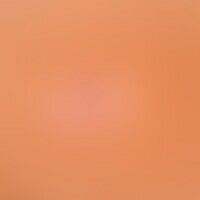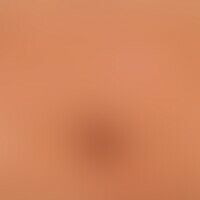
Striae cutis distensae L90.6
Striae cutis distensae, initially blue-reddish (Striae rubrae), later whitish, differently long and wide, jagged, parallel or diverging atrophic stripes with slightly sunken and thinned, transversely folded, smooth skin.

Vitiligo (overview) L80
Vitiligo: First appearance 4 years ago of differently sized, differently configured, sharply defined, progressive, differently intensely depigmented patches on the trunk and extremities of a 31-year-old patient with skin type IV.

Meese cross bands L60.8
Meesche transverse ligaments: 56 year old woman. 3 months before the present picture was taken, the patient had severe bronchitis. The symmetrical white transverse ligament of all fingernails indicates the temporary, systemic disturbance of the organism. Picture from the collection of Dr. med. Eva Kämmerer

Vitiligo (overview) L80
Vitiligo: on the upper part of the upper arm spatter-like vitiligo, on the forearm extensive depigmentation.

Nevus anaemicus Q82.5
Naevus anaemicus: irregularly limited, white, smooth stain, "always have been there". after rubbing the stain, in contrast to the healthy environment, no reddening occurs.

Pityriasis versicolor (overview) B36.0
Pityriasis versicolor alba: completely asymptomatic, non-scaly patches on the back that appear regularly after the summer months.

Vitiligo (overview) L80
Vitiligo: infestation of the eyelids and the adjacent cheek area. spot-shaped repigmentation. defined by square: white tinting of the eyelashes

Lichen planus mucosae L43.8
Differential diagnosis Lichen planus mucosae - present mucosal changes in systemic lupus erythematosus with white veil-like plaques and extensive (painful) erosions of the buccal mucosa; plaques in the region of the dental fissure densified.

Nevus melanocytic halo-nevus D22.L

Pityriasis versicolor alba B36.0
Pityriasis versicolor alba: irregularly distributed, symptomless, bright spots, which in places have merged to form larger areas, appearing after repeated exposure to sunlight.

Pityriasis versicolor (overview) B36.0
Pityriasis versicolor: Large and small, slightly scaly, only occasionally slightly itchy, bright, bizarrely shaped spots (Pityriasis versicolor alba).

Idiopathic guttate hypomelanosis L81.5
Hypomelanosis guttata idiopathica: Multiple, chronic, for years increasing, disseminated, mainly at the light exposed areas, preferably localized on the stretching side, 0.2-0.4 cm large, round, symptomless, white, slightly rough spots.

Pityriasis versicolor alba B36.0
Pityriasis versicolor alba: irregularly distributed, symptomless, bright spots that appeared after repeated exposure to sunlight.

Nevus melanocytic halo-nevus D22.L

Hypomelanosis ito Q82.3
Hypomelanosis Ito: Striped and extensive depigmentation, no other symptoms, no other organic malformations.

Half-and-half nails L60.8
Half and half nail: Zonal, slightly blurred white coloration of the proximal and brown coloration of the distal nail plate; no underlying disease known.

Vitiligo (overview) L80

Vitiligo (overview) L80
Vitiligo: irregularly limited vitiligo zone marked by arrow with melanosis of the small labia.

Vitiligo (overview) L80
Vitiligo: (Detail enlargement): Multiple, since adolescence occurring, size-progressive, flat, partly bizarrely limited, bright spots on mamma and in the sternum area of a 28-year-old woman. The left areola mammae (areola) is largely depigmented.

Nevus anaemicus Q82.5
naevus anaemicus: congenital, irregularly dissected white, smooth stains at the edges. no reddening after rubbing the stain. on glass spatula pressure the boundaries to the surrounding area disappear.




